JEEP CHEROKEE 1988 Service Repair Manual
Manufacturer: JEEP, Model Year: 1988, Model line: CHEROKEE, Model: JEEP CHEROKEE 1988Pages: 1378, PDF Size: 19.9 MB
Page 881 of 1378
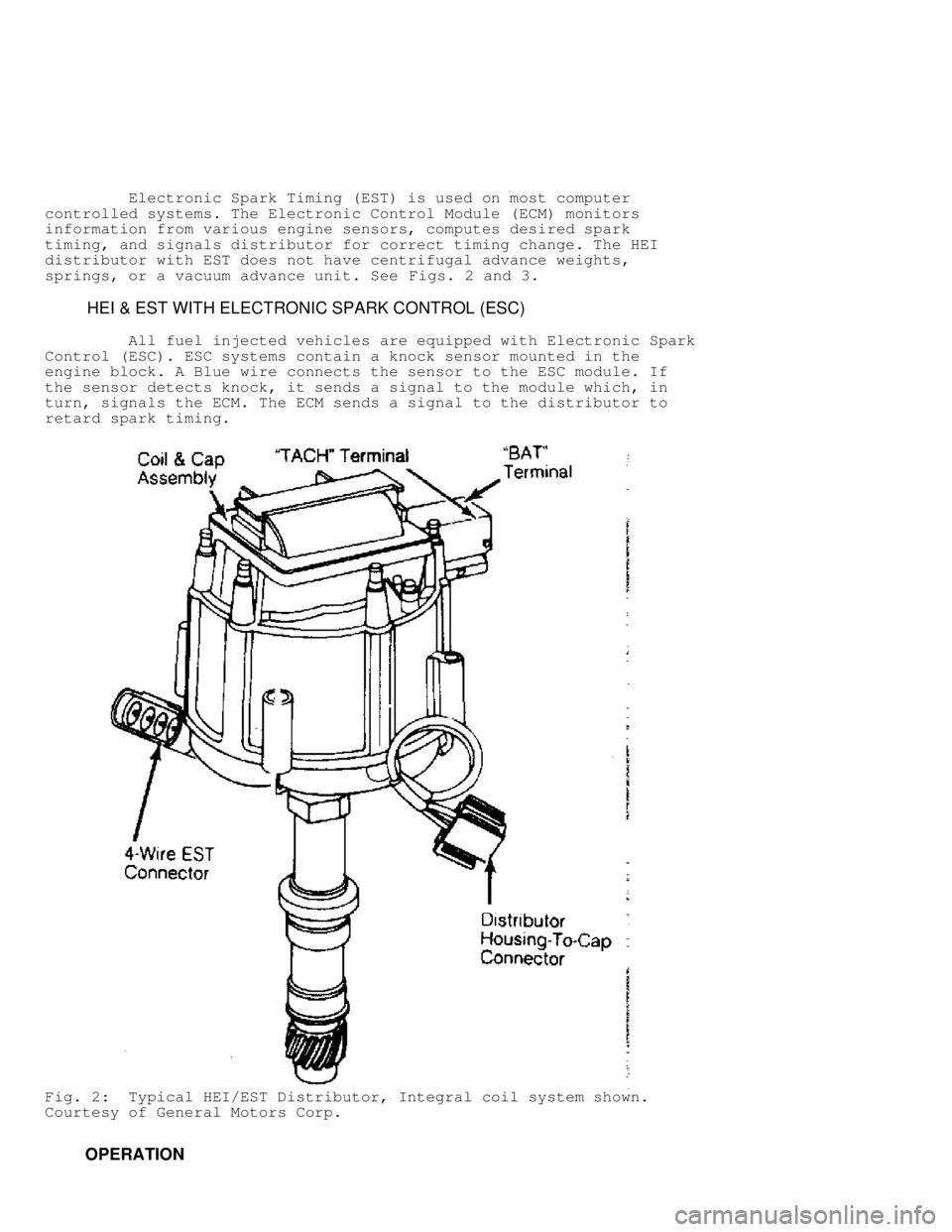
Electronic Spark Timing (EST) is used on most computer
controlled systems. The Electronic Control Module (ECM) monitors
information from various engine sensors, computes desired spark
timing, and signals distributor for correct timing change. The HEI
distributor with EST does not have centrifugal advance weights,
springs, or a vacuum advance unit. See Figs. 2 and 3.
HEI & EST WITH ELECTRONIC SPARK CONTROL (ESC)
All fuel injected vehicles are equipped with Electronic Spark
Control (ESC). ESC systems contain a knock sensor mounted in the
engine block. A Blue wire connects the sensor to the ESC module. If
the sensor detects knock, it sends a signal to the module which, in
turn, signals the ECM. The ECM sends a signal to the distributor to
retard spark timing.
Fig. 2: Typical HEI/EST Distributor, Integral coil system shown.
Courtesy of General Motors Corp.
OPERATION
Page 882 of 1378
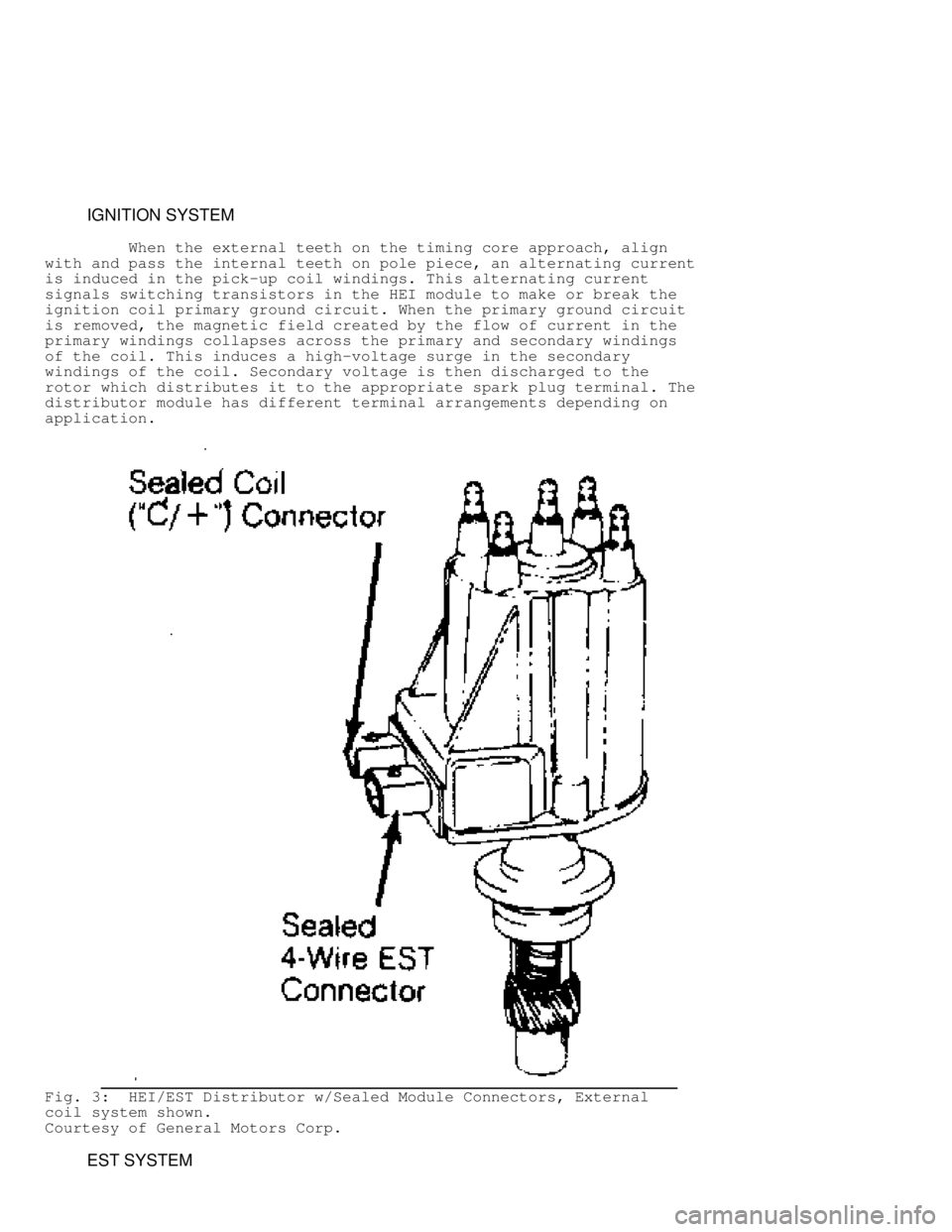
IGNITION SYSTEM
When the external teeth on the timing core approach, align
with and pass the internal teeth on pole piece, an alternating current
is induced in the pick-up coil windings. This alternating current
signals switching transistors in the HEI module to make or break the
ignition coil primary ground circuit. When the primary ground circuit
is removed, the magnetic field created by the flow of current in the
primary windings collapses across the primary and secondary windings
of the coil. This induces a high-voltage surge in the secondary
windings of the coil. Secondary voltage is then discharged to the
rotor which distributes it to the appropriate spark plug terminal. The
distributor module has different terminal arrangements depending on
application.
Fig. 3: HEI/EST Distributor w/Sealed Module Connectors, External
coil system shown.
Courtesy of General Motors Corp.
EST SYSTEM
Page 883 of 1378

The ECM monitors information concerning crankshaft position,
engine RPM, engine load, atmospheric conditions, engine temperature,
and transmission gear position. This information is used by the ECM to
compute desired spark timing which is relayed to the distributor,
enabling appropriate changes to be made to ignition timing. A back-up
spark advance system is incorporated to signal ignition module in the
event of ECM failure.
CAUTION: Although similar in appearance, components of HEI/EST and
HEI distributors are NOT interchangeable.
All Models With EST
The distributor module is connected to ECM by a 4-wire EST
connector which performs the following functions:
* Terminal "A" of the 4-wire connector is the reference ground
low. It is grounded in the distributor and ensures ground
circuit does not have a voltage drop. If circuit is open,
engine may experience poor performance.
* Terminal "B" of the 4-wire connector is the by-pass circuit.
At about 400 RPM, ECM applies 5 volts to this circuit to
switch spark timing control from module to ECM. An open or
grounded by-pass circuit will set a code 42 and the engine
will operate at base timing, plus a slight amount of advance
built into the module.
* Terminal "C" is the distributor reference High circuit. This
circuit provides the ECM with RPM and crankshaft position
information.
* Terminal "D" is the EST circuit, which triggers the module.
The ECM does not know what actual timing is, but does know
when it receives the reference signal. It will advance or
retard spark from that point. If base timing is set
incorrectly, engine spark curve will be incorrect.
SENSORS
On EST systems, the coolant temperature sensor signals ECM to
advance timing on a cold engine and return timing to programmed
advance curve as engine reaches normal operating temperature. If
engine overheats, spark is retarded to prevent detonation. During
light throttle operation, throttle position sensor input to ECM allows
for additional advance.
Spark advance is also governed by input from engine RPM and
Manifold Absolute Pressure (MAP) sensor. When MAP output voltage is
low (high vacuum), ECM gives less spark advance. More spark advance is\
given when MAP output voltage is high (low vacuum).
ELECTRONIC SPARK CONTROL (ESC) SYSTEM
All Fuel Injected Engines
The basic components of Electronic Spark Control (ESC) system\
are detonation (knock) sensor, HEI/EST distributor, ESC module and
ECM. When detonation (knock) occurs, sensor sends an electrical signal\
to ESC module. The ESC module then sends the signal voltage to the
ECM. When the ECM senses a voltage drop (to less than one volt) on the\
knock sensor signal line, spark timing will be retarded. The ECM will
retard spark timing until all signals from detonation sensor cease.
See Fig. 4 .
Page 884 of 1378
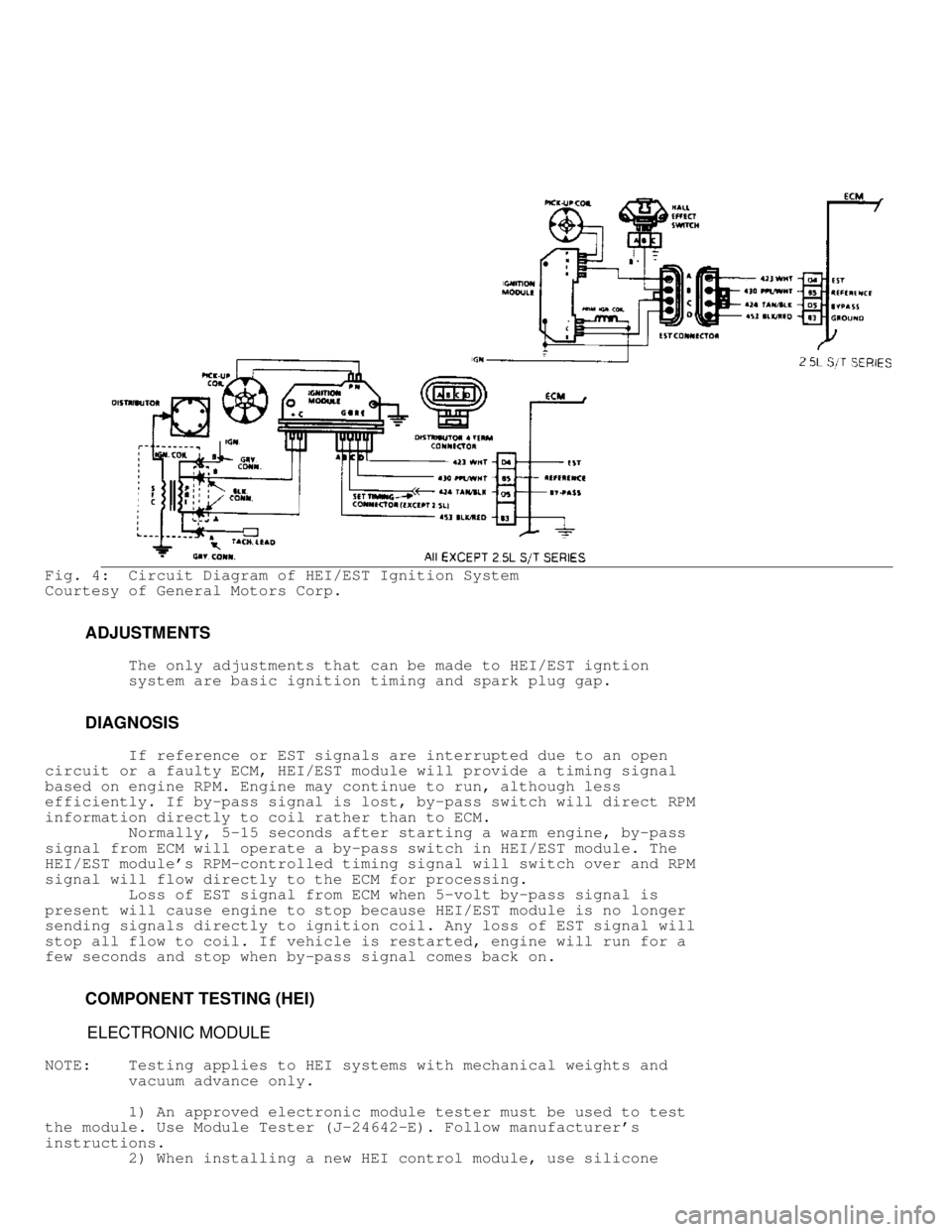
Fig. 4: Circuit Diagram of HEI/EST Ignition System
Courtesy of General Motors Corp.
ADJUSTMENTS
The only adjustments that can be made to HEI/EST igntion
system are basic ignition timing and spark plug gap.
DIAGNOSIS
If reference or EST signals are interrupted due to an open
circuit or a faulty ECM, HEI/EST module will provide a timing signal
based on engine RPM. Engine may continue to run, although less
efficiently. If by-pass signal is lost, by-pass switch will direct RPM
information directly to coil rather than to ECM.
Normally, 5-15 seconds after starting a warm engine, by-pass
signal from ECM will operate a by-pass switch in HEI/EST module. The
HEI/EST module's RPM-controlled timing signal will switch over and RPM
signal will flow directly to the ECM for processing.
Loss of EST signal from ECM when 5-volt by-pass signal is
present will cause engine to stop because HEI/EST module is no longer
sending signals directly to ignition coil. Any loss of EST signal will
stop all flow to coil. If vehicle is restarted, engine will run for a
few seconds and stop when by-pass signal comes back on.
COMPONENT TESTING (HEI)
ELECTRONIC MODULE
NOTE: Testing applies to HEI systems with mechanical weights and
vacuum advance only.
1) An approved electronic module tester must be used to test
the module. Use Module Tester (J-24642-E). Follow manufacturer's
instructions.
2) When installing a new HEI control module, use silicone
Page 885 of 1378
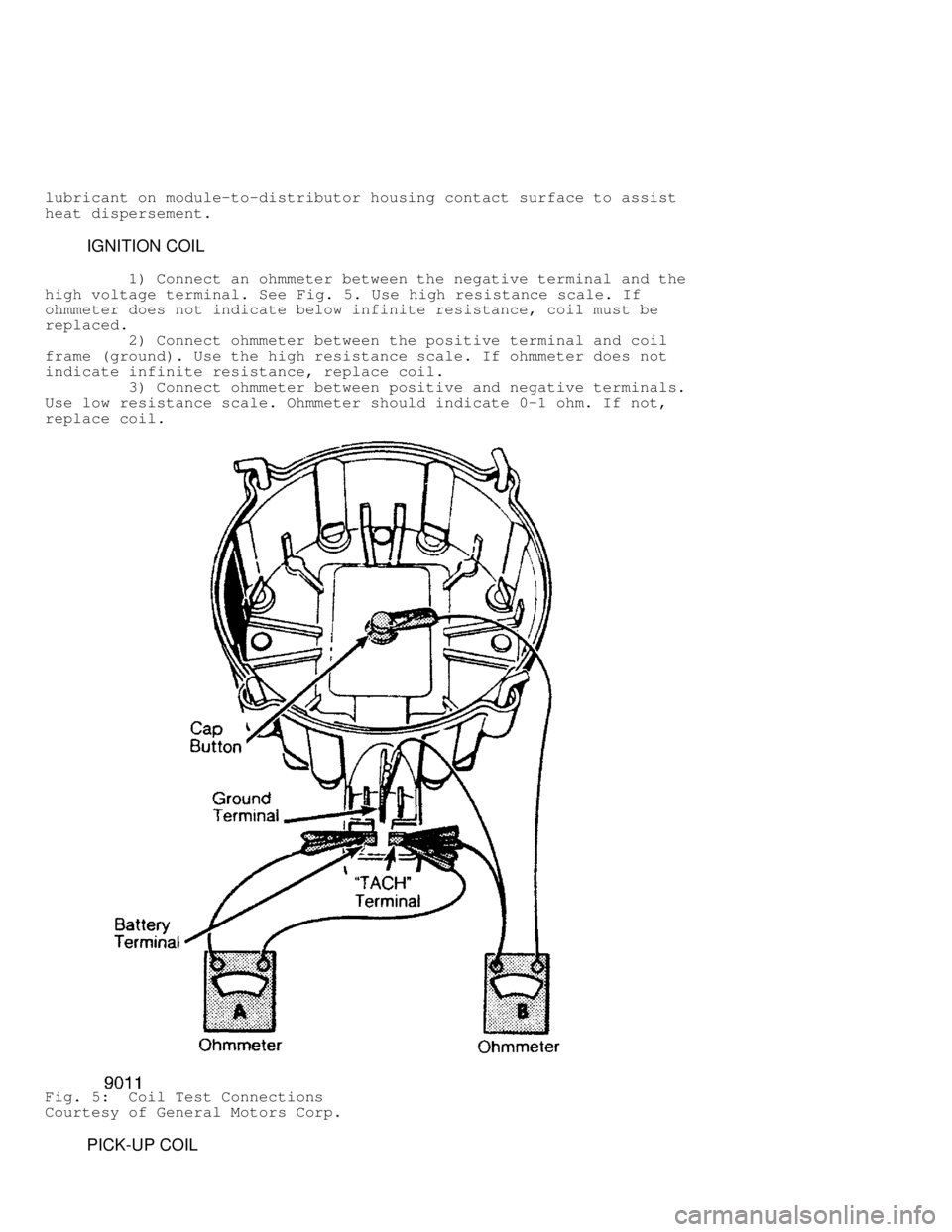
lubricant on module-to-distributor housing contact surface to assist
heat dispersement.
IGNITION COIL
1) Connect an ohmmeter between the negative terminal and the
high voltage terminal. See Fig. 5. Use high resistance scale. If
ohmmeter does not indicate below infinite resistance, coil must be
replaced.
2) Connect ohmmeter between the positive terminal and coil
frame (ground). Use the high resistance scale. If ohmmeter does not
indicate infinite resistance, replace coil.
3) Connect ohmmeter between positive and negative terminals.
Use low resistance scale. Ohmmeter should indicate 0-1 ohm. If not,
replace coil.
Fig. 5: Coil Test Connections
Courtesy of General Motors Corp.
PICK-UP COIL
Page 886 of 1378
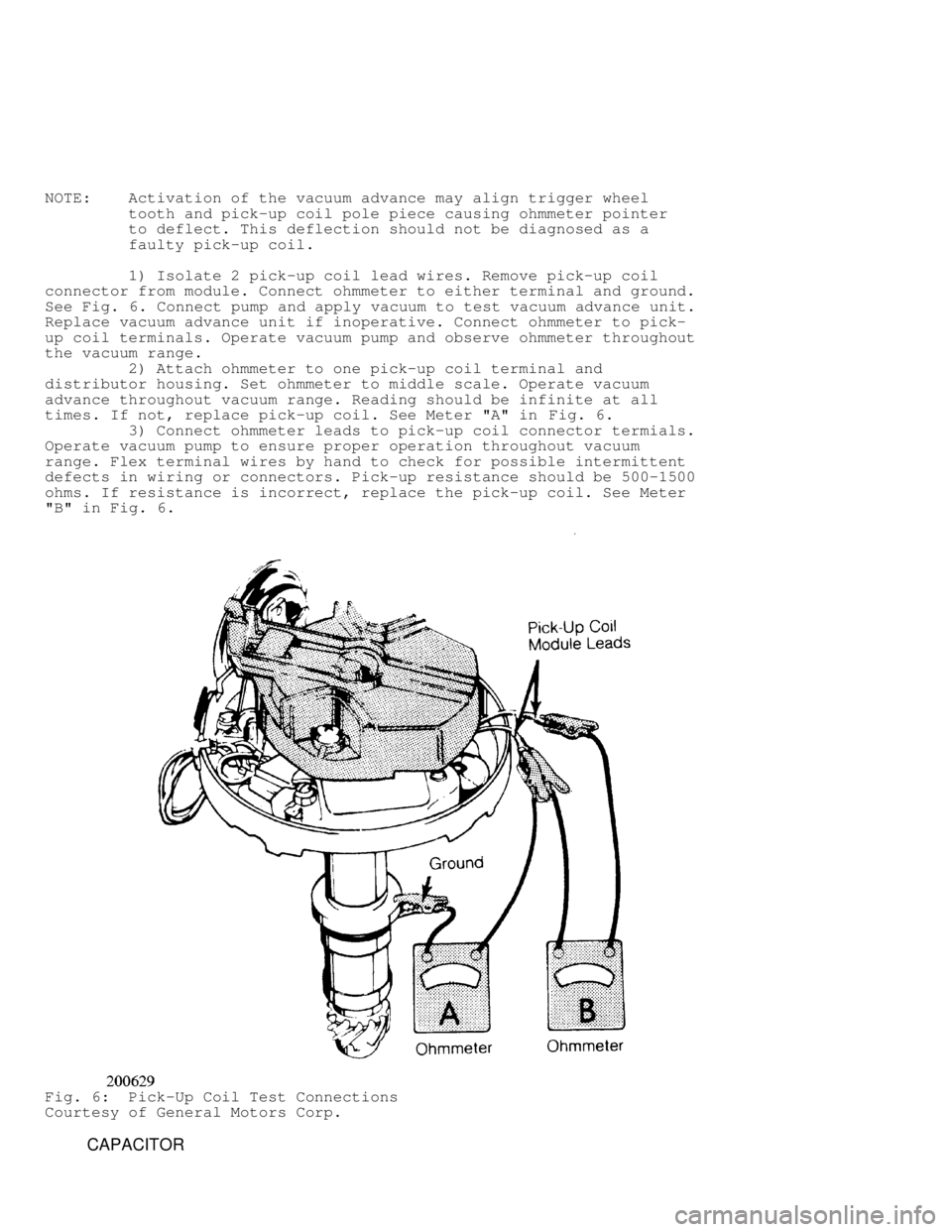
NOTE: Activation of the vacuum advance may align trigger wheel
tooth and pick-up coil pole piece causing ohmmeter pointer
to deflect. This deflection should not be diagnosed as a
faulty pick-up coil.
1) Isolate 2 pick-up coil lead wires. Remove pick-up coil
connector from module. Connect ohmmeter to either terminal and ground.
See Fig. 6 . Connect pump and apply vacuum to test vacuum advance unit.
Replace vacuum advance unit if inoperative. Connect ohmmeter to pick-
up coil terminals. Operate vacuum pump and observe ohmmeter throughout
the vacuum range.
2) Attach ohmmeter to one pick-up coil terminal and
distributor housing. Set ohmmeter to middle scale. Operate vacuum
advance throughout vacuum range. Reading should be infinite at all
times. If not, replace pick-up coil. See Meter "A" in Fig. 6.
3) Connect ohmmeter leads to pick-up coil connector termials.
Operate vacuum pump to ensure proper operation throughout vacuum
range. Flex terminal wires by hand to check for possible intermittent
defects in wiring or connectors. Pick-up resistance should be 500-1500
ohms. If resistance is incorrect, replace the pick-up coil. See Meter
"B" in Fig. 6.
Fig. 6: Pick-Up Coil Test Connections
Courtesy of General Motors Corp.
CAPACITOR
Page 887 of 1378
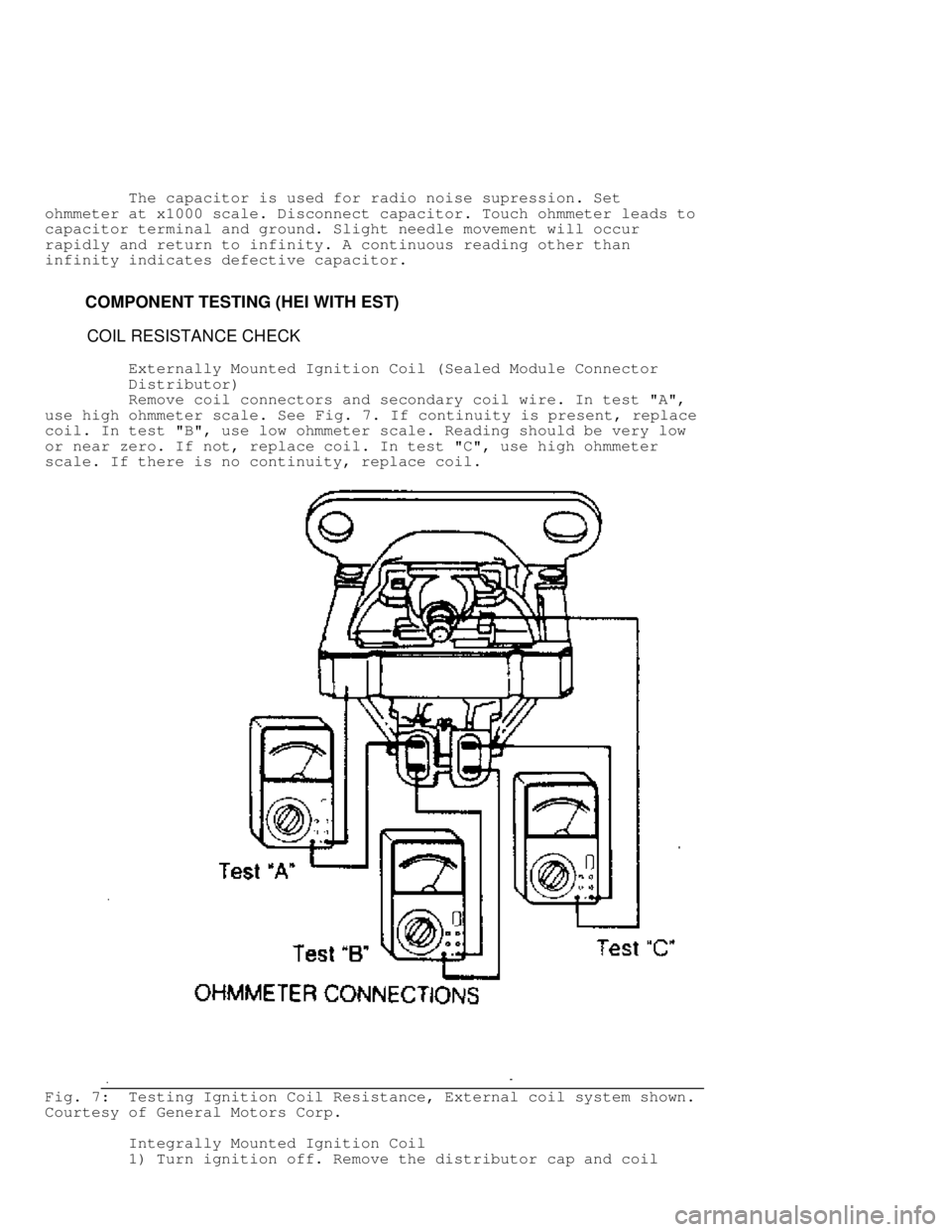
The capacitor is used for radio noise supression. Set
ohmmeter at x1000 scale. Disconnect capacitor. Touch ohmmeter leads to
capacitor terminal and ground. Slight needle movement will occur
rapidly and return to infinity. A continuous reading other than
infinity indicates defective capacitor.
COMPONENT TESTING (HEI WITH EST)
COIL RESISTANCE CHECK
Externally Mounted Ignition Coil (Sealed Module Connector
Distributor)
Remove coil connectors and secondary coil wire. In test "A",
use high ohmmeter scale. See Fig. 7. If continuity is present, replace
coil. In test "B", use low ohmmeter scale. Reading should be very low
or near zero. If not, replace coil. In test "C", use high ohmmeter
scale. If there is no continuity, replace coil.
Fig. 7: Testing Ignition Coil Resistance, External coil system shown.
Courtesy of General Motors Corp.
Integrally Mounted Ignition Coil
1) Turn ignition off. Remove the distributor cap and coil
Page 888 of 1378
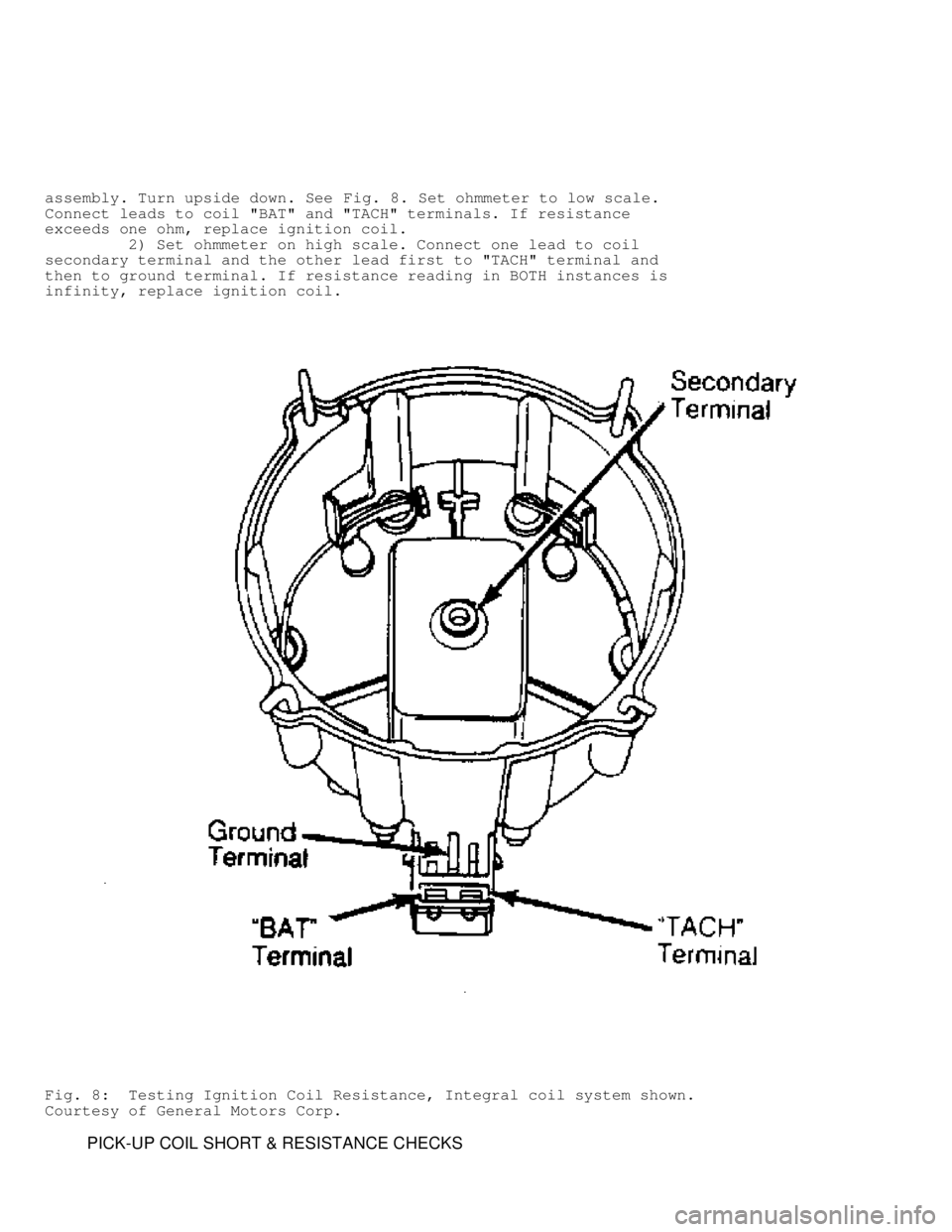
assembly. Turn upside down. See Fig. 8. Set ohmmeter to low scale.
Connect leads to coil "BAT" and "TACH" terminals. If resistance
exceeds one ohm, replace ignition coil.
2) Set ohmmeter on high scale. Connect one lead to coil
secondary terminal and the other lead first to "TACH" terminal and
then to ground terminal. If resistance reading in BOTH instances is
infinity, replace ignition coil.
Fig. 8: Testing Ignition Coil Resistance, Integral coil system shown.
Courtesy of General Motors Corp.
PICK-UP COIL SHORT & RESISTANCE CHECKS
Page 889 of 1378
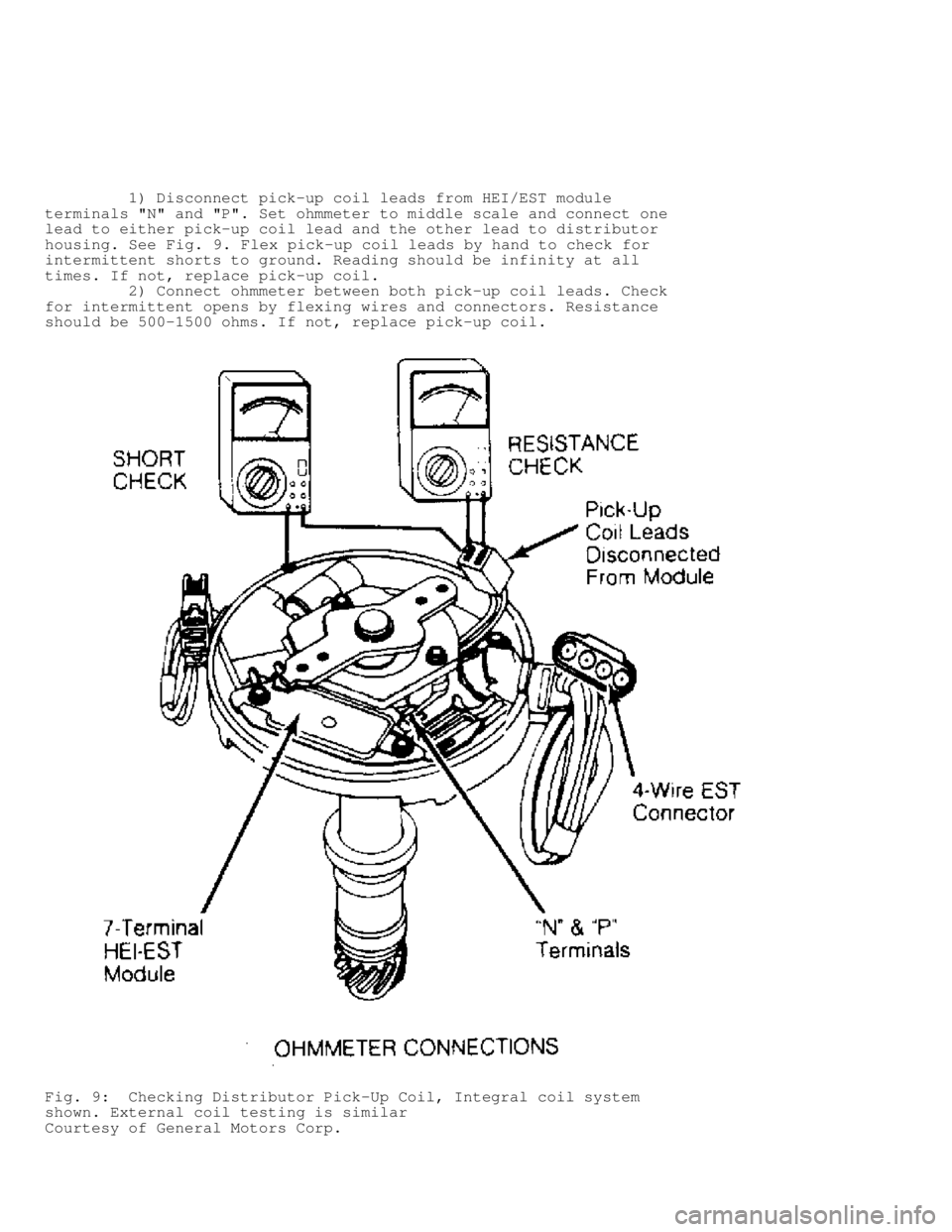
1) Disconnect pick-up coil leads from HEI/EST module
terminals "N" and "P". Set ohmmeter to middle scale and connect one
lead to either pick-up coil lead and the other lead to distributor
housing. See Fig. 9. Flex pick-up coil leads by hand to check for
intermittent shorts to ground. Reading should be infinity at all
times. If not, replace pick-up coil.
2) Connect ohmmeter between both pick-up coil leads. Check
for intermittent opens by flexing wires and connectors. Resistance
should be 500-1500 ohms. If not, replace pick-up coil.
Fig. 9: Checking Distributor Pick-Up Coil, Integral coil system
shown. External coil testing is similar
Courtesy of General Motors Corp.
Page 890 of 1378
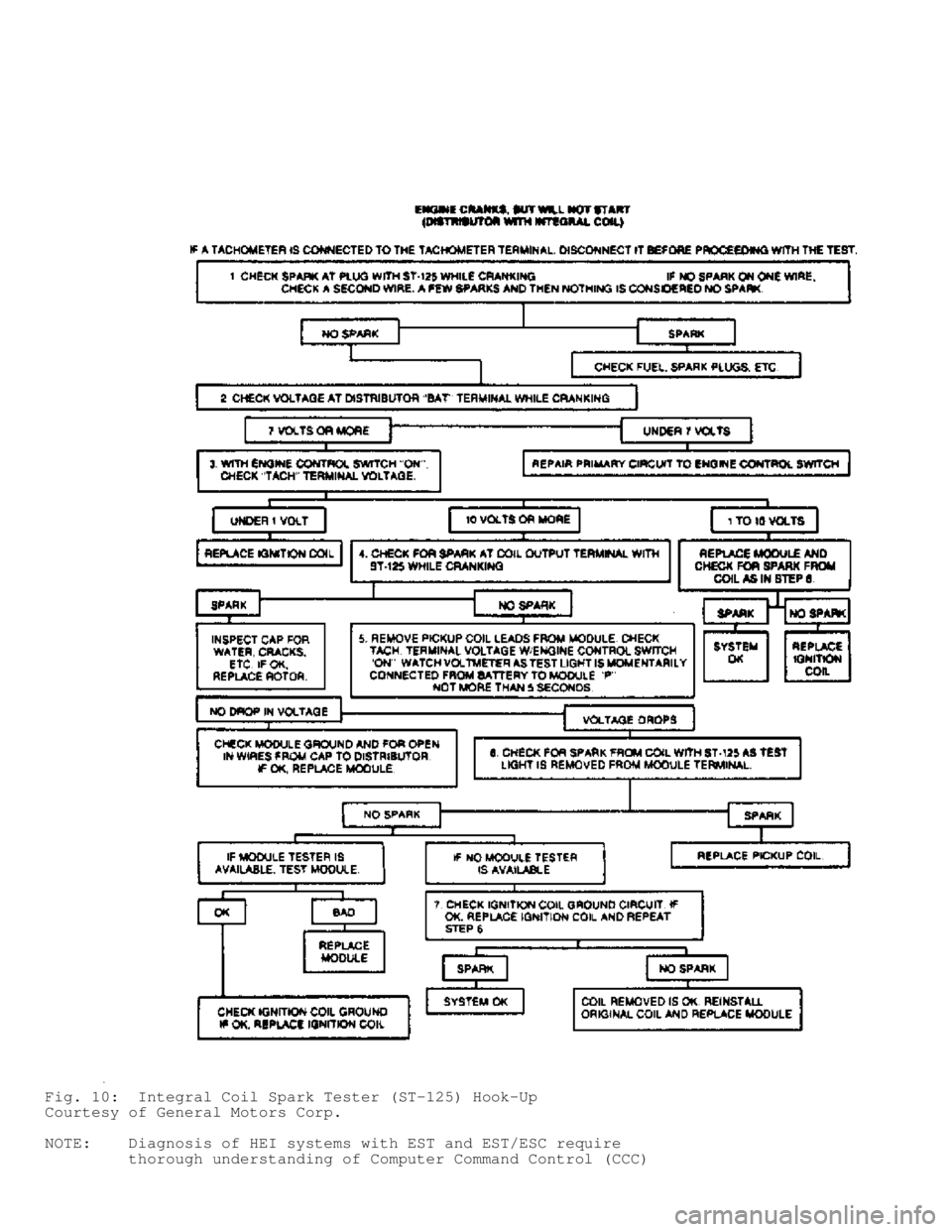
Fig. 10: Integral Coil Spark Tester (ST-125) Hook-Up
Courtesy of General Motors Corp.
NOTE: Diagnosis of HEI systems with EST and EST/ESC require
thorough understanding of Computer Command Control (CCC)